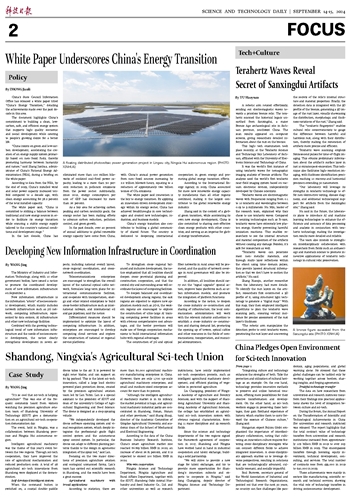
 |
| A bronze figure excavated from the Sanxingdui site. (PHOTO: XINHUA) |
A robotic arm rotated effortlessly, sending out electromagnetic waves towards a priceless bronze relic. The terahertz scanned the historical legacy unearthed from Sanxingdui, a major Bronze Age archaeological site in Sichuan province, southwest China. The scan results appeared on computer screens, giving researchers detailed information about the rust on the bronze.
This high-tech examination took place recently, at the Terahertz Science and Technology Key Laboratory of Sichuan, affiliated with the University of Electronic Science and Technology of China.
It was the world's first instance of using terahertz waves for tomographic imaging analysis of bronze artifacts. The analysis used the world's first terahertz near-field imaging system based on vacuum electronic devices, independently developed by Chinese scientists.
Terahertz waves are electromagnetic waves with frequencies ranging from 0.1 to 10 terahertz and wavelengths between 0.03 to 3 millimeters. Hu Min, leader of the research team, explained why they chose to use terahertz waves. Compared to ionizing technologies such as X-rays, terahertz waves have extremely low photon energy, thereby preventing harmful ionization reactions. This enables researchers to see the internal structure and material composition of the artifacts without causing any damage. Besides, it's safe for researchers as well.
"Terahertz waves can penetrate most non-metallic materials, and through multi-layer reflections within the object using time-domain pulses, they provide layered structural information so that we don't have to section the artifacts," Hu said.
Zhang Xiaoqiu, another researcher from the laboratory, had more details. To identify the rust layers on the artifact, researchers first constructed a 3D profile of it, using structured light technology to generate a "digital map." With this map, they then employed intelligent algorithms to plan the terahertz wave scanning path, ensuring vertical incidence for precise assessment of the rust layer's thickness.
"The robotic arm manipulates the detection probe to emit terahertz waves, penetrating the rust layer and uncovering the secrets of the relic's internal structure and material properties. Finally, the detection data is integrated with the 3D profile of the bronze, generating a 3D image of the rust layer, visually showcasing the distribution, morphology, and thickness variations of the rust," Zhang said.
The "terahertz fingerprint" enables cultural relic conservationists to gauge the difference between harmful and harmless rust, along with their distribution, thereby making the restoration of artifacts more precise and efficient.
Terahertz wave scanning employs femtosecond pulses for time-of-flight imaging. This obtains preliminary information about the artifact's surface layer in just 10 minutes post-excavation. This technique also facilitates high-resolution imaging, with thickness identification precision reaching 10 microns and horizontal precision extending 50 nanometers.
"Our laboratory will leverage its strengths in terahertz technology to offer non-destructive testing, disease diagnosis, and additional technological support for artifacts from the Sanxingdui site," Zhang said.
Hu said in the future, the laboratory plans to introduce AI and machine learning technologies to enhance the efficiency and accuracy of data processing and analysis in conjunction with terahertz technology, making the investigation results more detailed and reliable.
The team also intends to strengthen interdisciplinary collaboration with researchers from fields such as archaeology and materials science to promote innovative applications of terahertz technology in cultural relic preservation.


 Next
Next




